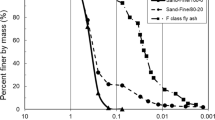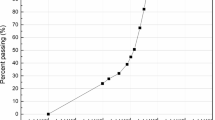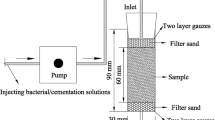Abstract
Bio-cementation is currently applied to solidify sandy soils, but only few studies use it to cement loess soil particles. In this study, the microbially induced carbonate precipitation (MICP) method was used to solidify loess soils. In addition, loess is widely distributed in the regions of northwest of China, where repeated seasonal freeze-thaw results in the structural damages in loess. Therefore, the freeze-thaw cycle test was conducted to study the durability of bio-treated loess soils. Results showed that the permeability coefficients of all samples decreased during the solidification, but the change pattern varied greatly because of different densities. Calcium carbonate (CaCO3) in samples with smaller densities distributed relatively uniformly. After solidification, the content of large aggregates and small pores increased, and the content of small aggregates and large pores decreased. For samples with a density of 1.5 g/cm3, the content of large aggregates was the largest and the content of small aggregates was the smallest. Moreover, compared with untreated samples, increasing freeze-thaw cycles resulted in a larger increase in sonic time values of treated samples, but their mass and strengths significantly decreased. The increase in freeze-thaw cycles decreased the difference between sonic time values in solidified samples, while porosity and contents of large pores increased regardless of density. Overall, after bio-cementation, the solidified samples with a density of 1.5 g/cm3 had better aggregate effect and resistance for freeze-thaw cycles, and a uniform solidification effect, which present promising potential for application of MICP in the field.







Similar content being viewed by others
Data availability
Some data, models, or code were generated or used during the study.
References
Al Qabany A, Soga K (2013) Effect of chemical treatment used in MICP on engineering properties of cemented soils. Geotechnique 63:331–339
Atashgahi S, Tabarsa A, Shahryari A, Hosseini S (2020) Effect of carbonate precipitating bacteria on strength and hydraulic characteristics of loess soil. Bull Eng Geol Environ
Cheng L, Shahin M, Chu J (2019) Soil bio-cementation using a new one-phase low-ph injection method. Acta Geotech 14(3):615–626
DeJong J, Fritzges M, Nusslein K (2006) Microbially induced cementation to control sand response to undrained shear. J Geotech Geoenviron Eng 132:1381–1392
Dejong J, Soga K, Banwart S et al (2011) Soil engineering in vivo: harnessing natural biogeochemical systems for sustainable, multi-functional engineering solutions. J R Soc Interface 8(54):1–15
Derbyshire E, Meng X, Dijkstra T (2000) Landslides in the thick loess terrain of North-West China. John Wiley and Sons Ltd, London
De Muynck W, Debrouwer D, De Belie N et al (2008) Bacterial carbonate precipitation improves the durability of cementitious materials. Cem Concr Res 38(7):1005–1014
Harkes M, Van Paassen L, Booster J, Whiffin V, van Loosdrecht M (2010) Fixation and distribution of bacterial activity in sand to induce carbonate precipitation for ground reinforcement. Ecol Eng 36(2):112–117
Hommel J, Lauchnor E, Phillips A, Gerlach R, Cunningham A, Helmig R et al (2015) A revised model for microbially induced calcite precipitation: improvements and new insights based on recent experiments. Water Resour Res 51(5):3695–3715
Gowthaman S, Nakashima K, Kawasaki S (2020) Freeze-thaw durability and shear responses of cemented slope soil treated by microbial induced carbonate precipitation. Soils Found 60(4):840–855
Ji J, Li H, Yan G (2008) Effect of temperature on ultrasonic wave velocity in concrete. J Build Mater 11(3):349–352 (in Chinese)
Juang C, Dijkstra T, Wasowski J, Meng X (2019) Loess geohazards research in China: advances and challenges for mega engineering projects. Eng Geol 251:1–10
Leng Y, Peng J, Wang Q, Meng Z, Huang W (2018) A fluidized landslide occurred in the Loess Plateau: a study on loess landslide in South Jingyang Tableland. Eng Geol 236:129–136
Li Q, Dong L, Li X, Yin Z, Liu X (2011) Effects of sonic speed on location accuracy of acoustic emission source in rocks. Trans Nonferrous Metals Soc China 21(12):2719–2726
Liu Z, Liu F, Ma F, Wang M, Bai X, Zheng Y, Yin H, Zhang G (2016) Collapsibility, composition, and microstructure of loess in China. Can Geotech J 53(4):673–686
Mahawish A, Bouazza A, Gates W (2018) Effect of particle size distribution on the bio-cementation of coarse aggregates. Acta Geotech 13(4):1019–1025
Miao L, Wu L, Sun X, Li X, Zhang J (2020) Method of solidifying desert sands with enzyme-catalysed mineralization. Land Degrad Dev 31(11):1317–1324
Mitchell A, Phillips A, Kaszuba J et al (2008) Microbially enhanced carbonate mineralization and the geologic containment of CO2. Geochim Cosmochim Acta 72(12):636–636
Mitchell J, Santamarina C (2005) Biological considerations in geotechnical engineering. J Geotech Geoenviron 131(10):1222–1233
Paassen L (2009) Biogrout ground improvement by microbially induced carbonate precipitation, PhD thesis. Delft University of Technology, Netherlands
Paassen L, Ghose R, Linden T et al (2010) Quantifying bio-mediated ground improvement by ureolysis: a large scale biogrout experiment. J Geotech Geoenviron Eng 136(12):1721–1728
Peng D, Xu Q, Liu F, He Y, Zhang S, Qi X, Zhao K, Zhang X (2018) Distribution and failure modes of the landslides in Heitai terrace. China Eng Geol 236:97–110
Salifu E, Maclachlan E, Iyer K et al (2015) Application of microbially induced calcite precipitation in erosion mitigation and stabilisation of sandy soil foreshore slopes: a preliminary investigation. Eng Geol 201(4):96–105
Smalley I (1995) Making the material: the formation of silt sized primary mineral particles for loess deposits. Quat Sci Rev 14(7–8):645–651
Stocks-Fischer S, Galinat J, Bang S (1999) Microbiological precipitation of CaCO3. Soil Biol Biochem 31(11):1563–1571
Sun X, Miao L, Tong T, Wang C (2018a) Study of the effect of temperature on microbially induced carbonate precipitation. Acta Geotech 14(3):627–638
Sun X, Miao L, Tong T, Wang C (2018b) Improvement of microbial-induced calcium carbonate precipitation technology for sand solidification. J Mater Civ Eng 30(11):04018301
Sun X, Miao L, Wang C (2019a) Glucose addition improves the bio-remediation efficiency for crack repair. Mater Struct 52(6):111
Sun X, Miao L, Wu L, Chen R (2019b) The improvement of bio-cementation at low temperature based on Bacillus megaterium. Appl Microbiol Biotechnol 103(17):7191–7202
Sun X, Miao L, Chen R (2019c) Effects of different clay's percentages on improvement of sand-clay mixtures with microbially induced calcite precipitation. Geomicrobiol J 1-9
Sun X, Miao L, Wu L (2020a) Applicability and theoretical calculation of enzymatic calcium carbonate precipitation for sand improvement. Geomicrobiol J:1–11
Sun X, Miao L, Chen R (2020b) The application of bio-cementation for improvement of collapsibility of loess. Int J Environ Sci Technol:1–9
Sun X, Miao L, Yuan J, Wang H, Wu L (2020c) Application of enzymatic calcification for dust control and rainfall erosion resistance improvement. Sci Total Environ
Sun X, Miao L, Wu L, Wang H (2021a) Theoretical quantification for cracks repair based on microbially induced carbonate precipitation (micp) method. Cem Concr Compos 1:103950
Sun X, Miao L, Wang H, Yin W, Wu L (2021b) Mineralization crust field experiment for desert sand solidification based on enzymatic calcification. J Environ Manag 287:112315
Terzis D, Bernier-Latmani R, Laloui L (2016) Fabric characteristics and mechanical response of bio-improved sand to various treatment conditions. Geotech Lett 6(1)
Trofimov V, Balykova S, Andreeva T, Ershova A (2015) Subsidence of buried soils in cyclic loess sequences of the northern Eurasia. In: Engineering Geology for Society and Territory-Volume 5. Springer, Cham, pp 439–442
Whiffin V (2004) Microbial CaCO3 precipitation for the production of biocement. Murdoch University, Perth
Whiffin V, van Paassen L, Harkes M (2007) Microbial carbonate precipitation as a soil improvement technique. Geomicrobiol J 24(5):417–423
Wu X (2003) Technical hand book for nondestructive testing of concrete. China Communications Press, Beijing
Xu L, Dai F, Tu X, Tham L, Zhou Y, Iqbal J (2014) Landslides in a loess platform, North-West China. Landslides 11(6):993–1005
Xu S, Wu Z, Zhao W, Zhao T (2017) Study of the microscopic pores of structured loess based on Matlab and IPP. China Earthquake Eng J 39(1):80–87 (in Chinese)
Zamani A, Montoya B (2016) Permeability reduction due to microbial induced calcite precipitation in sand. Geo-Chicago:94–103
Zhao J, Wang P, Li Z (2011) Subsoil disposal of expressway in damp loess area. Road Machin Constr Mechan 28(9):43–45
Zhou L, Hou X, Wang Z (2014) The effect of the freeze-thaw cycles in nanometer pores on the cement structure. Appl Mech Mater 488-489:620–624
Acknowledgements
The authors thank the valuable comments from the reviewers.
Funding
This study was funded by National Natural Science Foundation of China (grant number 51578147), Fundamental Research Funds for the Central Universities (grant number 2242020R20025) and Science and Technology Department of Ningxia (grant number 2020BFG02014).
Author information
Authors and Affiliations
Contributions
XS and LM conceived and designed research. XS, HW and RC conducted experiments. XS and XG analyzed data and wrote the manuscript. All authors read and approved the manuscript.
Corresponding author
Ethics declarations
Conflict of interest
The authors declare no competing interests.
Rights and permissions
About this article
Cite this article
Sun, X., Miao, L., Wang, H. et al. Improvement of characteristics and freeze-thaw durability of solidified loess based on microbially induced carbonate precipitation. Bull Eng Geol Environ 80, 4957–4966 (2021). https://doi.org/10.1007/s10064-021-02241-2
Received:
Accepted:
Published:
Issue Date:
DOI: https://doi.org/10.1007/s10064-021-02241-2




